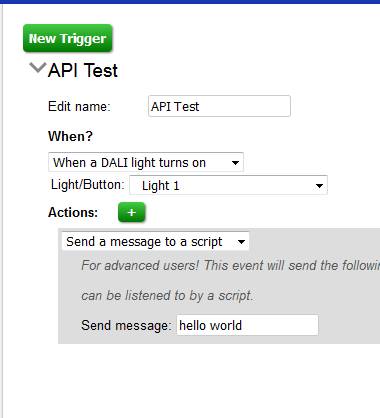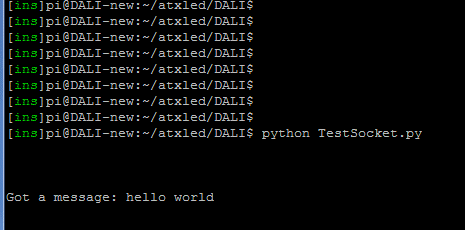ZWD API
There are 3 types of API interfaces
- Hue Emulation - appears to App and other devices as if it were a Hue Hub - see our Hue emulation documentation
- ZWD API transmit - this is how a user script can send lighting control commands
- ZWD API receive - this is how a user script can receive commands from the lighting bus
user script to ZWD API
Python Example of the API for ZWD (see AL-DALI-HAT datasheet for details)
-----------------------------------------------------------------------------
# first set all to 50%
# then to off
# then to 100%
# then to off
# then read level from the device at address 1
import requests
import time
headers = {
'Content-type': 'application/json',
}
# set all to 50%
D_on80 = '{"channel":0,"commands":["hFE80"]}'
# set all to 100%
D_on = '{"channel":0,"commands":["hFEFE"]}'
# set all to 0%
D_off = '{"channel":0,"commands":["hFF00"]}'
# read back the current level of address 1
D_query = '{"channel":0,"commands":["h03A0"]}'
# multicommand ( all off, all on, all off )
D_OffOnOff = '{"channel":0,"commands":["hFE00","h0AFE","hFE00"]}'
----------------------------------
# send a command string
response = requests.post('http://localhost/dali/api/send-raw', headers=headers, data=D_on)
if response.status_code == 200 :
print("Success, result data %s"%response.text)
# response would be
{"ok":true,"responses":["N","N","N"]}
from ZWD to user script API
#!/usr/bin/env python3 # This is an example script for the ATX-LED streaming event API.
# This code waits for messages from the ZWD server, which are triggered
# in the Schedule or Macro pages. To use this code, set up a scheduled
# event or a macro, and select 'Send a message to a script' in the Action
# dropdown. You can choose to specify a string of characters to send to
# this script (as specified in the above action). This message will be sent
# to this script (in the form of a UTF-8 encoded string of bytes), and the
# code within main() below can decide what to do based on the message.
# the variable [DALI1] and [DALI2] if found in the string, will be replaced by the first and 2nd
# bytes of the DALI command that triggered the Macro, thus one script can service many
# buttons in a 8B, 010v or DR2-nWay
# do not create a file or directory "api-events"
import os
import socket
SOCKET_PATH = '/home/pi/atxled/api-events'
def main():
for message in listen_for_messages():
# Application logic goes here!
# You can parse the message and do whatever you want here.
print('Got a message: %s' % message) # This generator function waits for messages. You probably don't need to modify it. def listen_for_messages(): sock = socket.socket(socket.AF_UNIX, socket.SOCK_STREAM) try:
sock.bind(SOCKET_PATH)
sock.listen(0) # queue 0 responses
while True:
[conn, addr] = sock.accept()
message = conn.recv(64)
yield message
conn.close() finally:
os.unlink(SOCKET_PATH) if __name__ == '__main__': main()
| 
Important notes on this trigger - the trigger is sent when a 0 -> 1 transition occurs, multi "On" with no intermediate "Off" will not create a trigger event.

|